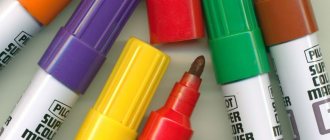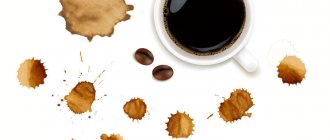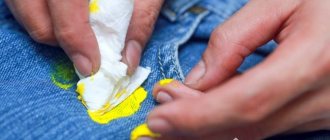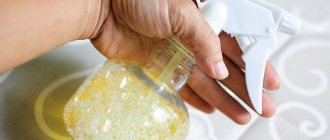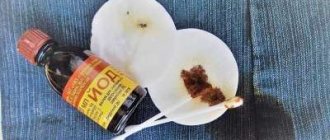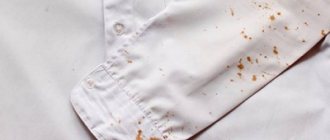Black clothing is a hit with both men and women. Everyone has a dark T-shirt, shirt or dress in their wardrobe, from which it is difficult to remove white marks. This type of contamination remains on clothing from the use of antiperspirant deodorants. The products help in terms of personal hygiene, but they leave stains that are difficult to remove.
Removing deodorant from your armpits is not easy, but it is possible. Do not rush to throw away the item if the stains do not come off after washing. There are ways to remove stains on clothes from antiperspirants that help with fresh and old stains.
Preparatory process
Not many people know how to remove white spots on black clothes in order to preserve the color and not spoil the item. To effectively clean the product, the first step is to determine the origin of the contamination; white remains on black from:
- deodorants;
- decorative cosmetics;
- sweat;
- glue.
Light stains remain from detergents that were poorly rinsed during washing; they are easy to deal with; just do an additional rinse in the machine. The glue is removed using special chemicals in dry cleaning; other stains can be removed at home. You don’t have to make any special efforts; everything you need for cleansing is in every home’s kitchen and medicine cabinet.
Before removing white stains from black clothes, their origin is determined. Select a removal method, test the product on an inconspicuous area of the product, if the tissue reacts normally, carry out the cleaning process. Washing the entire wardrobe item after the manipulations is required.
How to remove using folk remedies?
There are folk remedies that can be called universal. With their help you can get rid of any types of stains. The compounds are safe for most materials if used correctly:
Hydrogen peroxide .
This cheap product works great on animal stains. Peroxide quickly removes traces of sweat, blood, fat and more. The substance has a bleaching effect, so it should be used with caution when treating dyed fabrics.- Soda. It is used both dry and diluted. Powder is sprinkled on greasy stains, and soda paste is applied to almost any stain. You can also soak the entire item in the solution.
- Vinegar. To combat various types of stains, 9% acid is used. It can be dangerous to use more concentrated solutions on fabric.
- Ammonia . It is used both as a single agent and in combination with other substances.
Removing fresh traces
How to remove deodorant stains on dark and black things quickly and efficiently? Is it possible to do it at home? Removing traces is possible; household products are used for this.
Traces of deodorant on clothing can be removed in several ways, each will be effective if you strictly follow the recommended proportions and do not overexpose the solutions and products used. This way the color and structure of the fabric will be preserved, and your favorite item will last a long time. The following methods will help you quickly clean things:
- This type of contamination can be removed with laundry soap. Traces of deodorant on linen are moistened with cool water, soaped generously, and left for 30-90 minutes, depending on the degree of damage. The soap solution will be washed out along with the deodorant.
- How to remove white stains from deodorant on dark-colored items? Table vinegar from the kitchen is considered the first assistant. Apply the product to problem areas overnight, moistening them generously. In the morning, just rinse and wash; you can wash without rinsing.
- A strong solution of kitchen salt will remove stains within an hour. It is prepared at the rate of 150-200 g per liter of water. The laundry is placed completely in the solution and waited.
- Lemon juice will help remove sweat and traces of auxiliary products. The substance is applied to the stained areas for several minutes using cotton swabs. The next stage includes washing with laundry soap. After 20-30 minutes, the item of clothing is washed completely.
- Dish detergent will cope with the task, how to remove stains under the arms from antiperspirant correctly? The kitchen product is not diluted with anything; it is applied in concentrated form to problem areas. Leave for a couple of hours, rinse under running water.
- They knew for a long time how to remove white stains on black clothes; vodka was used for this purpose. The dirt was poured generously with alcohol, and after half an hour it was rinsed well. The vodka was washed out along with the dirt, and the smell was removed using standard washing.
- Denatured alcohol knows how to remove traces of deodorant on dark-colored clothes. Apply the product generously to problem areas and wait no more than an hour. Washing will remove other imperfections.
Washing at temperatures up to 40 degrees will help to consolidate the effectiveness of the substance used; higher rates will cause stains or will not wash out the stain remover completely.
Stage one
So let's get started.
First, you need to prepare the product: you need to check how it will react to the stain removers that you are going to use. It is best to first test it on some unnecessary thing made from the same material. If you don't do this, you risk simply ruining the product. It’s also worth determining what actually stained your clothes. It would take a long time to list all types of stains; we won’t do that.
The most important tip: do not use hot water to wash a stained item (otherwise you will only set the stains and not remove them). So wash your clothes at 40 degrees (but not higher). And be sure to treat soiled items only from the inside out - this way, after cleaning, there will be no streaks left on the items. And after washing and removing the stain, it is best to dry things on a line on the balcony or in the open air (it is not advisable to use a battery, since drying too quickly can again lead to the appearance of streaks). We briefly list all the means that you can use to remove white stains from black clothes:
How to remove white stains from old deodorant?
It is more difficult to clean a wardrobe item with an old stain of any origin; the contamination is firmly embedded in the fibers of the fabric. Traces on clothing from personal hygiene products in fresh form are difficult to remove; old ones will require the use of complex formulations of various substances. It’s easy to prepare the solutions; we look for the ingredients in the monastery.
How can I remove stains from an outdated type of antiperspirant? The tips are:
- The simplest method is to rub a large amount of kitchen salt into the dirty areas. After 12 hours, the item of clothing in the wash will release salt and traces of dirt.
- How to remove deodorant stains on old items that cannot be removed by salt? A miraculous solution of 4 spoons of peroxide, 1 spoon of dishwashing detergent, 2 spoons of soda can cope with such problems. The ingredients are mixed, applied to problem areas for a couple of hours, washed by hand or in a machine in cool water.
- Ammonia is what can be used to remove stains of various origins from many fabrics and preserve color. The trace is treated with a 50% ammonia solution; a couple of minutes will be enough for the reaction. Washing will fix the result.
- How to remove deodorant stains at home using hydrogen peroxide? The method will require another medication, aspirin. The tablets are kneaded, water is added to form a paste. Apply to the ingrained antiperspirant for a couple of hours, rinse. Soak in hydrogen peroxide and rinse again. If the contamination is not completely gone, the procedure is repeated.
In addition to traditional methods, an excellent way out of this situation would be to use a stain remover. When choosing a household chemical store, pay attention to the composition and manufacturer’s recommendations. Not every drug is suitable for black and dark wardrobe items.
How to remove deodorant stains using store-bought products? The process is very simple, the problem area is treated with the purchased product and wait for the time indicated on the package, rinse, and consolidate the results by washing.
Universal ways to get rid of white stains on black and colored
If the contact of chlorine bleach with an item of clothing or shoes was short, you can use several universal methods for removing stains. With their help, it is possible to restore the color of the fabric or disguise a defective area.
Color over with marker
To mask stains from whiteness, a pencil or marker with a suitable shade that matches the shade of the surface is suitable. To carry out the procedure, you need to carefully sketch the affected area, turn the item inside out and apply a damp piece of cotton fabric to the wrong side and smooth it with an iron.
The painting method is effective when the bleach has damaged a small area. If the whiteness appears on black fabric, then you should use cosmetic mascara or drawing mascara. The artistic composition is strongly absorbed into the fabric, covering the defective area, and is never washed off again. As a result, the owner of the item will not have to re-correct the painted area.
Dyeing clothes
If the bleach has damaged most of the fabric item, it will need to be completely redyed. To do this you need:
- Buy a special dye for the appropriate type of fiber.
- Dilute the mixture in water following the manufacturer's instructions.
- Dip the product into the solution (you can add salt to it for better coloring).
- Boil the item or paint it at a temperature of +40…+60 °C.
- Wait the required time (indicated on the label) and remove the painted item from the container.
- Rinse clothes in cold liquid adding 1 tbsp. l. vinegar.
It must be borne in mind that vinegar and salt have fixing properties. If a large area has been damaged on a dark item, the coloring may turn out uneven. During subsequent washes, the area will be highlighted with a light shade. To eliminate the problem, you should treat the damaged area with dye again to even out the color.
Embroidery or patch
A damaged piece of clothing can be repaired with embroidery. You can also disguise the area with an applique or a sewn pocket. If there are drops of bleach on a pocket, cuff, belt or collar, you can replace these elements without much difficulty.
First of all, you will need to wash the stained part, select a compatible material, make a pattern and sew the area in place. If you do not have the skills to carry out such procedures, you should seek help from a studio or an experienced seamstress.
To make the stain invisible, you can buy threads and stitch in the desired place, using the criss-cross method or along and across.
Such a patch will not only hide dirt, but also decorate your clothes. The main thing is to show a little imagination.
Useful tips
We found out how to remove traces of deodorant on dark-colored wardrobe items. To preserve the color and appearance of the product, it is worth learning some tips and tricks:
- Use products and medications taking into account expiration dates. Expired ones will have a negative effect on the fibers.
- Processing is carried out from the wrong side to avoid streaks.
- Soaking with powder or other detergent will not give results.
- Hot water will worsen the problem and the antiperspirant will penetrate even deeper.
- It is necessary to dry salvaged laundry in natural conditions, away from radiators and heaters. They can cause light stains on clothing.
- It is difficult to get rid of traces of deodorant on a black item, but their appearance can be avoided. Apply deodorant only to clean, dry skin, then wait until it dries completely. For aerosols, a couple of minutes is enough, gel ones need about five.
In the process of getting rid of the problem, do not rub the clothes too much; many fabrics quickly lose their shape when handled aggressively. Remember, fresh tracks will run away faster and more efficiently.
As it turns out, you can remove deodorant stains with improvised means found in every home. Use these tips and enjoy the cleanliness of your favorite things.
How long does it take to neutralize whiteness?
To avoid damage to the fabric item, you must immediately begin to neutralize the chlorine bleach. It is recommended to do this within 25-30 minutes of contact with the object. If you delay the process, the chances of removing contaminants will be reduced to zero. At the same time, using plain water to remove stains is ineffective - it will only help get rid of residual chemical components.
Hydrogen peroxide
Yellowish stains that have appeared recently and occupy a small area of matter can be removed with hydrogen peroxide. You can buy the product at any pharmacy without a prescription. It is not only an antiseptic, but also a high-quality bleach.
In addition to the peroxide itself, you will need a cotton pad and a bar of laundry soap. All traces of a yellow tint should be thoroughly wiped with a cosmetic disc generously soaked in the solution. Then lather and wash. The item should be rinsed under cold running water. If streaks remain, the manipulation must be repeated.
What is used
To wash and bleach things manually and not spoil them, you need to know which fabrics can be exposed to high temperatures and what you will need for this.
Boil down
Before you start boiling, you need to select a container that can hold at least a bucket of water. An enameled pan without chips, cracks and rust, galvanized boiling water, is suitable for this purpose.
Wooden tongs
In order for the laundry to boil evenly, you need to mix it and take it out not with your hands, but to specially select a device in the form of a stick, a large wooden spoon or tongs.
Features of washing shirts made of linen, cotton and silk
Linen is recommended to be washed at 40ºC. Some products can withstand 60ºC. When using higher temperatures, greater shrinkage of the material (5-10%) should be taken into account. It is impossible to return the size to the original one.
Lower washing temperatures do not affect the cleanliness of the laundry. Linen is characterized by a special fiber structure. The material becomes less dirty, but also easier to clean. Therefore, most often the use of high temperature conditions is not required.
Cotton is a light, soft, pleasant-to-touch material. Therefore, it is not surprising that it is so popular. The washed item wrinkles a lot, but the fabric can withstand high temperatures. Therefore, it can be easily ironed. You can wash a white cotton shirt at 90ºC. Colored items will lose color faster at this temperature.
Silk is a unique material that protects from both heat and cold. But caring for it is very difficult. We recommend hand washing in warm water with a mild detergent or shampoo. Classic washing powders can stain silk or disturb its color.
Baking soda
Sodium bicarbonate also does a good job of removing stubborn stains that have an unpleasant yellow or brown tint. This is the most affordable remedy, because baking soda can be found in any housewife’s kitchen. To prepare the composition you will need 20-25 g of powder. It is diluted with water to a thick puree and applied to damaged areas. Leave for 1-2 hours, then rinse with cold water.
Which wash to choose
Washing machine vs hand washing? Most people will choose the first option. This is a more convenient and faster way. But both methods have advantages and disadvantages. The choice depends mainly on the degree of soiling of the shirt and time constraints.
Handwash
Fill a basin with warm water and wet your shirt in it. Add some detergent. Leave for 30-60 minutes. Then clean the cuffs, collar, and other dirty areas. Wash your clothes. To prevent your shirt from shrinking after washing, do not use water warmer than 40ºC.
Expert opinion
Irina Kovtun
For a snow-white look, add a little blue or a few drops of blue ink to the rinsing water. Use very little product, otherwise you will get blue instead of white.
Salt and alcohol
A mixture of ammonia and table salt will help remove dirty yellow marks on linen or cotton fabric. Use the composition only on materials of natural origin. This method is also not recommended for delicate items, since large salt crystals can damage the structure of the fibers.
To prepare the composition, you need to take 10 g of salt and 10 ml of ammonia, mix thoroughly and apply to the contaminated area. The item is left alone for 30-40 minutes, then washed with laundry soap for a stronger effect.

